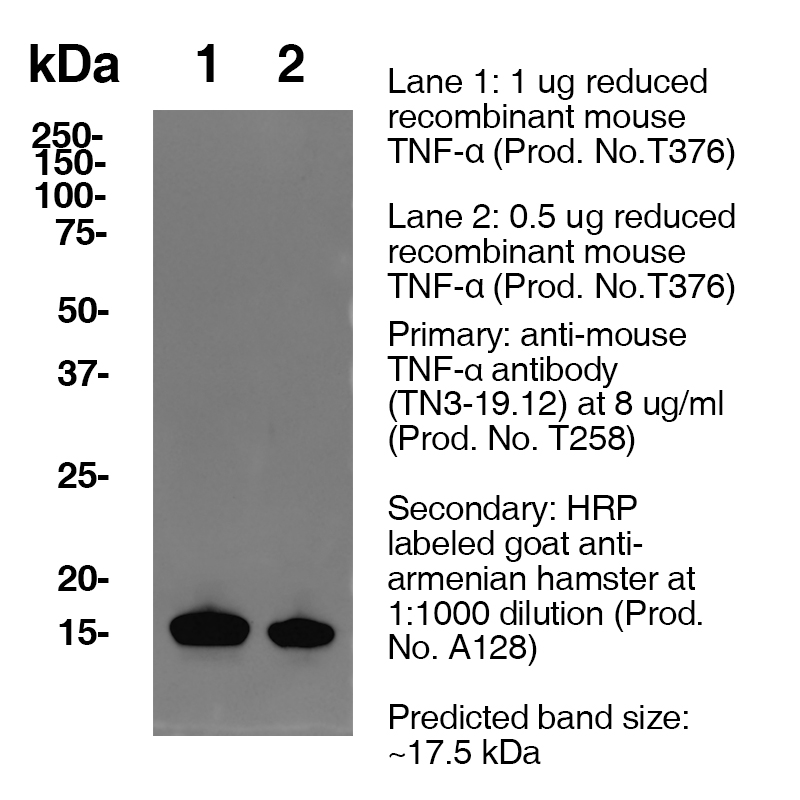Mouse TNFα Antibody – Purified in vivo GOLD™ Functional Grade
Mouse TNFα Antibody – Purified in vivo GOLD™ Functional Grade
Product No.: T258
- -
- -
Clone TN3-19.12 Target TNF-α Formats AvailableView All Product Type Monoclonal Antibody Alternate Names Tumor Necrosis Factor Ligand Superfamily Member 2 (TNFSF2), Cachectin, Differentiation-Inducing Factor (DIF), Necrosin, Cytotoxin Isotype IgG Applications in vivo , IP , N , WB |
Data
- -
- -
Antibody DetailsProduct DetailsReactive Species Mouse Host Species Armenian Hamster Recommended Isotype Controls Recommended Dilution Buffer Immunogen Recombinant mouse TNFα Product Concentration ≥ 5.0 mg/ml Endotoxin Level < 1.0 EU/mg as determined by the LAL method Purity ≥95% monomer by analytical SEC ⋅ >95% by SDS Page Formulation This monoclonal antibody is aseptically packaged and formulated in 0.01 M phosphate buffered saline (150 mM NaCl) PBS pH 7.2 - 7.4 with no carrier protein, potassium, calcium or preservatives added. Due to inherent biochemical properties of antibodies, certain products may be prone to precipitation over time. Precipitation may be removed by aseptic centrifugation and/or filtration. Product Preparation Functional grade preclinical antibodies are manufactured in an animal free facility using in vitro cell culture techniques and are purified by a multi-step process including the use of protein A or G to assure extremely low levels of endotoxins, leachable protein A or aggregates. Storage and Handling Functional grade preclinical antibodies may be stored sterile as received at 2-8°C for up to one month. For longer term storage, aseptically aliquot in working volumes without diluting and store at ≤ -70°C. Avoid Repeated Freeze Thaw Cycles. Country of Origin USA Shipping Next Day 2-8°C RRIDAB_2737571 Applications and Recommended Usage? Quality Tested by Leinco ELISA: Each lot of this antibody is quality control tested by ELISA assay. For use of this antibody as a capture, a concentration range of 2 - 6 µg/ml is recommended. To obtain a linear standard curve, serial dilutions of mouse TNF-α recombinant protein ranging from 500 to 4 pg/ml are recommended for each ELISA plate. It is recommended that the reagent be titrated for optimal performance for each application. Additional Reported Applications For Relevant Conjugates ? N: Clone TN3-19.12 has been shown to neutralize murine TNFα WB IP FC Each investigator should determine their own optimal working dilution for specific applications. See directions on lot specific datasheets, as information may periodically change. DescriptionDescriptionSpecificity Armenian Hamster Anti-Mouse TNFa (Clone TN3-19.12 ) recognizes Mouse TNFa. This monoclonal antibody was purified using multi-step affinity chromatography methods such as Protein A or G depending on the species and isotype. Background The tumor necrosis factor (TNF-alpha) is a multifaceted polypeptide cytokine known as a mediator of inflammation and immunity.1 It may mediate some of the significant changes in cellular homeostasis which accompany the invasion of the mammalian host by viruses, bacteria, and parasites.2 TNF-α is an acute phase protein which initiates a cascade of cytokines and increases vascular permeability, thereby recruiting macrophage and neutrophils to a site of infection. TNF-α secreted by the macrophage causes blood clotting which serves to contain the infection. TNF-α has been detected in synovial fluid of patients with rheumatoid arthritis. Clone TN3-19.12 antibody can neutralize the bioactivity of natural or recombinant TNF-α Antigen Distribution Activated monocytes, neutrophils, macrophages, T cells, B cells, NK cells, LAK cells NCBI Gene Bank ID UniProt.org Research Area Immunology . Innate Immunity References & Citations1.) El-Harith el-HA et al. (2004) Saudi Med J. 25: 135 2.) Adolf GR et al. (1990) Infec Immun. 58: 3996 3.) Czepielewski, R. et al. (2021) Immunity 54(12):2795-2811.e9 Journal Link Technical ProtocolsCertificate of Analysis |
Related Products
- -
- -
Prod No. | Description |
|---|---|
S211 | |
R1364 | |
I-140 | |
C247 | |
F1175 | |
S225 | |
A132 | |
S571 |



